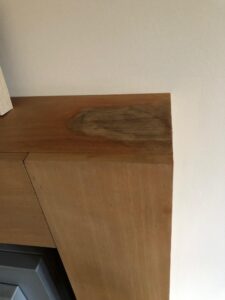Spilled paint thinner can be a difficult and dangerous mess to clean up. In this article, we will provide step-by-step instructions for safely cleaning up spilled paint thinner and disposing of it properly.
By following these guidelines, you can effectively remove paint thinner from a variety of surfaces and minimize the risk of fire or other accidents.
How to clean up spilled paint thinner
Cleaning up spilled paint thinner can be a challenging and potentially dangerous task. Paint thinner is a highly flammable liquid that can easily spread over large areas and seep into porous surfaces, making it difficult to completely remove. In addition, inhaling the vapors from paint thinner can be harmful to your health.
If you have spilled paint thinner, it is important to act quickly to minimize the risk of fire or other accidents. Follow these steps to safely clean up the spill:
- First and foremost, make sure that the area is well-ventilated. Open windows and doors and turn on fans to help disperse any vapors.
- If the spill is small, use a rag or paper towel to absorb as much of the paint thinner as possible. Be sure to dispose of the rag or paper towel in a metal container with a tight-fitting lid, such as a paint can, to prevent fires.
- If the spill is large or has spread to a large area, use sand, cat litter, or baking soda to absorb the paint thinner. Sprinkle the absorbent material over the spill and allow it to sit for several hours to soak up the liquid.
- Once the paint thinner has been absorbed, sweep or shovel up the absorbent material and dispose of it in a metal container with a tight-fitting lid.
- If the spill has spread to a porous surface such as concrete or wood, it may be necessary to use a solvent to remove the paint thinner. Acetone or mineral spirits can be effective at dissolving paint thinner. Be sure to use caution when handling solvents and follow the manufacturer’s instructions for safe use.
- Once the spill has been cleaned up, be sure to wash your hands thoroughly with soap and water.
In summary, cleaning up spilled paint thinner requires caution and quick action. By following these steps, you can safely remove paint thinner from a variety of surfaces and minimize the risk of fire or other accidents.
Does paint thinner leave a residue?
Paint thinner can leave a residue on surfaces that it comes into contact with. The residue is typically a thin, oily film that can be difficult to remove. The type and amount of residue left by paint thinner will depend on the specific product being used, as well as the surface it is being used on.
Paint thinner is often used to clean paint brushes and other tools, and it can leave a residue on the bristles or surface of the tool. This can be especially problematic if the paint thinner is not thoroughly rinsed off before the tool is used again.
To minimize the amount of residue left by paint thinner, it is important to use it sparingly and to thoroughly rinse off any surfaces that come into contact with it. If a residue does occur, it can often be removed by washing the surface with soap and water or a degreaser. In some cases, it may be necessary to use a solvent or strong cleaner to remove the residue. Be sure to test any cleaning product in a small, inconspicuous area first to ensure that it does not damage the surface.
How do you get rid of paint thinner stains?
Paint thinner stains can be difficult to remove, as the thin consistency of the liquid allows it to easily spread over large areas and seep into porous surfaces. However, there are a few steps you can take to try to remove paint thinner stains:
- First, blot the stain with a rag or paper towel to absorb as much of the paint thinner as possible.
- Next, try using a commercial solvent or stain remover to remove the stain. Products such as acetone or mineral spirits can be effective at dissolving paint thinner stains. Follow the manufacturer’s instructions for safe use and be sure to test the product in a small, inconspicuous area first to ensure that it does not damage the surface.
- If the stain remains, you may need to use a stronger cleaner. Try using a mixture of equal parts water and white vinegar to create a cleaning solution. Apply the solution to the stain and scrub it with a scrub brush or sponge. Rinse the area thoroughly with water and repeat if necessary.
- If the stain still persists, you may need to use a heavy-duty cleaner such as trisodium phosphate (TSP) or a degreaser. Be sure to follow the manufacturer’s instructions for safe use and test the product in a small, inconspicuous area first to ensure that it does not damage the surface.
- If the stain still remains after trying these methods, it may be necessary to call a professional cleaning service to remove it.
It is important to act quickly when trying to remove paint thinner stains, as the longer the stain is allowed to set, the harder it will be to remove. In addition, be sure to wear gloves and protective eyewear when working with solvents or strong cleaners to protect your skin and eyes.
Can you rinse paint thinner down the sink?
It is generally not recommended to rinse paint thinner down the sink. Paint thinner is a hazardous material that can be harmful to the environment and to your plumbing system. When paint thinner is rinsed down the sink, it can contaminate the water supply and harm aquatic life.
In addition, paint thinner can damage your plumbing system by dissolving the protective coating on pipes and causing them to corrode. This can lead to costly repairs and water damage to your home.
Instead of rinsing paint thinner down the sink, it is recommended to dispose of it properly. You can do this by taking it to a hazardous waste disposal facility or by following the instructions on the paint thinner label. In some cases, it may be possible to recycle paint thinner by taking it to a recycling center that specializes in handling hazardous materials.
It is important to handle and dispose of paint thinner responsibly to protect the environment and your home. If you have a large amount of paint thinner to dispose of, it is generally best to contact a professional hazardous waste disposal company to handle the job safely and efficiently.
How long does it take for the paint thinner to evaporate?
The rate at which paint thinner will evaporate depends on several factors, including the temperature, humidity, and ventilation of the area. In general, paint thinner will evaporate faster in warm, dry, and well-ventilated conditions.
At room temperature (around 70°F), it may take anywhere from several hours to a few days for paint thinner to completely evaporate. If the temperature is higher, the paint thinner may evaporate more quickly. On the other hand, if the temperature is lower or the humidity is high, it may take longer for the paint thinner to evaporate.
It is important to use caution when working with paint thinner, as the vapors can be harmful to your health if inhaled. Be sure to work in a well-ventilated area and avoid breathing in the vapors. If you need to use paint thinner for an extended period of time, it is recommended to wear a respirator to protect your lungs.
Can paint thinner be flushed down the toilet?
It is generally not recommended to flush paint thinner down the toilet. Paint thinner is a hazardous material that can be harmful to the environment and to your plumbing system. When paint thinner is flushed down the toilet, it can contaminate the water supply and harm aquatic life.
In addition, paint thinner can damage your plumbing system by dissolving the protective coating on pipes and causing them to corrode. This can lead to costly repairs and water damage to your home.
Instead of flushing paint thinner down the toilet, it is recommended to dispose of it properly. You can do this by taking it to a hazardous waste disposal facility or by following the instructions on the paint thinner label. In some cases, it may be possible to recycle paint thinner by taking it to a recycling center that specializes in handling hazardous materials.
It is important to handle and dispose of paint thinner responsibly to protect the environment and your home. If you have a large amount of paint thinner to dispose of, it is generally best to contact a professional hazardous waste disposal company to handle the job safely and efficiently.
Other cleaning guides
How To Clean Enamel Paint From Paintbrush (Restore Your Brush!)
How To Clean A Hairbrush Lint (Very Easy Method)



